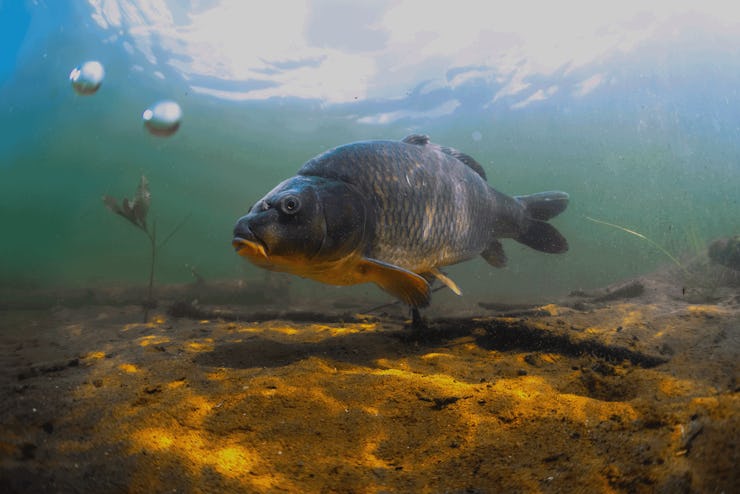What you need to know about the future of fish is swimming in a pond near you
Oceans get all the attention, but inland there may be more action.

Sea level rise tends to conjure images of land becoming submerged and of the oceans creeping farther into coastal cities. It may seem counterintuitive, then, that ocean fisheries are actually struggling.
But new research in the journal Fish and Fisheries shows that fish-eaters around the world could still get their fix in the future, if the international community recognizes the importance of fish that swim in lakes, ponds, rivers, and other inland bodies of water. We’re talking about the humble freshwater fish.
Researchers, funding foundations, and policymakers have long overlooked the freshwater fisheries when discussing global fisheries, a study published Thursday has found. Instead, the focus has been on ocean-based fisheries.
In many areas far from the coast, freshwater fish — carp and mola — make up a huge portion of the world’s food. They are a significant source of food and income for rural communities in particular, but they don’t get much attention when we talk about the future of food.
The fish population in oceans is dropping as seawater temperatures rise and overfishing persists. The sustainable fish catch has been declining for the past 80 years, which might be bad news for the fish that regularly appear on your plate — tuna and salmon, for instance.
“Inland fisheries are very often left out of the conversation,” study co-author Abigail Bennett, PhD., tells Inverse.
Freshwater fish are a crucial source of food and income for inland communities, but policymakers focus more on saltwater life.
Bennett, an assistant professor of fisheries and wildlife at Michigan State University, points to the United Nations Sustainable Development Goals as a prime example of this neglected priority: The agenda’s section on managing sealife focuses only on marine fisheries.
“That means that inland fisheries do not have a clear place in one of the most important international agendas of our time,” she says.
That may be, in part, because of what Bennett and her co-author call a “hidden harvest.” People living in rural areas may not report fish caught to feed their families, as opposed to fish caught to be sold, for example. As a result, inland fishing has been underreported by 21 to 51 percent, the study finds.
The findings support what fishery experts have long observed, highlighting the importance of inland fisheries for certain areas, like landlocked countries, Bennett says.
“Even in countries that do not report high inland fish catch, some communities are highly dependent on fish for nutrition and livelihoods,” Bennett says. “For example, inland fisheries production in Brazil is not particularly high, but some communities in the Amazon obtain almost all of their animal source protein form inland fish.”
Inland fish caught for subsistence rather than for sale are hugely underreported, the new study finds.
Boosting the profile of these freshwater fisheries could be a huge help to people in developing nations. About 95 percent of the world’s inland fisheries catch comes from developing countries, the authors write. They also note that more than half of the people employed in inland fisheries are likely to be women.
“Clearly, inland fisheries are providing nutrition and livelihoods for some of the most vulnerable people in the world,” Bennett says.
As climate change eats into the oceans’ fisheries, inland lakes and streams won’t be spared from the cost.
“Many inland fisheries are likely to be drastically affected by climate change,” Bennett points out. The severity will vary by body of water — a shallow lake will experience a different effect than a floodplain — as well as fishery location.
Inland fishers won't be spared the effects of climate change, and the international community needs to reckon with that reality.
Inland fisheries also face threats from dams used for hydropower and flood control, water that’s extracted for irrigation or municipal uses, and runoff and pollution from agriculture.
“There’s just so much competition for our freshwater systems,” Bennett says.
The study authors hope their findings can address the heavy focus on oceans in the past, which missed the importance of inland fisheries.
“We would like to see policy decisions explicitly account for impacts on inland fisheries and those who depend on them,” Bennett says. “Continuing to improve assessment methods will be key for recognizing and communicating the importance of inland fisheries in policy discussions.”
Abstract:
The role of inland fisheries in livelihoods, food security and sustainable development is often overshadowed by the higher profile interest in ocean issues. Whilst inland fisheries’ catch and contribution to global nutrition, food security and the economy, are less than that of marine fisheries, global‐level comparisons of fish production obscure considerable livelihood impacts in certain countries and sub‐national areas. To highlight these contributions, this paper synthesizes recent data and innovative approaches for assessing such livelihood contributions and their importance in countries with limited access to ocean resources and aquaculture. Inland fisheries are crucial for many socially, economically and nutritionally vulnerable groups of people around the world, but the challenges in monitoring inland fisheries preclude a complete understanding of the magnitude of their contributions. This situation is rapidly improving with increasing recognition of inland fisheries in development discourses, which has also encouraged research to enhance knowledge on the importance of inland fisheries. We review this work, including collated information published in a recent Food and Agriculture Organization report, to provide an up to date characterization of the state of knowledge on the role of inland fisheries.